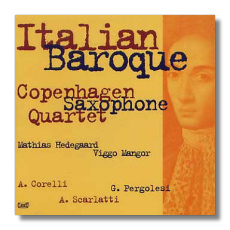
The Internet's Premier Classical Music Source
Related Links
- Latest Reviews
- More Reviews
-
By Composer
-
Collections
DVD & Blu-ray
Books
Concert Reviews
Articles/Interviews
Software
Audio
Search Amazon
Recommended Links
Site News
 CD Review
CD Review
Copenhagen Saxophone Quartet
Italian Baroque

- Arcangelo Corelli: Concerto grosso Op. 6 #8, "Fatto per la Notte di Natale"
- Giovanni Battista Pergolesi:
- Orfeo *
- Salve Regina *
- Alessandro Scarlatti:
- Concerto Grosso #1
- Concerto Grosso #2
* Matthias Hedegaard, tenor
Copenhagen Saxophone Quartet
Classico CLASSCD687 DDD 55:05
Also available on Kleos KL5144:
Amazon
- UK
- Germany
- Canada
- France
- Japan

- Arcangelo Corelli: Concerto grosso Op. 6 #8, "Fatto per la Notte di Natale"
- Giovanni Battista Pergolesi:
- Orfeo *
- Salve Regina *
- Alessandro Scarlatti:
- Concerto Grosso #1
- Concerto Grosso #2
Copenhagen Saxophone Quartet
Classico CLASSCD687 DDD 55:05
Baroque music is particularly adaptable, in the sense that it often sounds good no matter instrument you play it on. Bach's music, for example, has been successfully arranged for everything from percussion ensembles to synthesizers. The present CD ("Italian Baroque") takes music by three Italian composers of the Baroque era and presents it in arrangements for saxophone quartet – soprano, alto, tenor, and baritone saxophones, to be specific.
One can't make the argument that, "If Corelli had wanted his music to be played by saxophones, he would have composed it that way," because the first saxophone wasn't developed until around 1840 – more than a century after Corelli had died. Although we tend to associate the instrument with jazz – Boots Randolph, Sonny Stitt, and so on – there is nothing intrinsically jazzy about this instrument. It can be played with precision and a completely "straight" tone, or its notes can be bent and stretched and pulled around. On this disc, the members of the Copenhagen Saxophone Quartet are on their best behaviors, and I don't believe that Corelli, Pergolesi, and Scarlatti would have found fault with their sound or with the performances… once the initial surprise wore off! It's no more weird than listening to Baroque music arranged for brass, and the effect is not dissimilar. The arrangements are by soprano saxophonist Torben Snekkestad (Corelli and Scarlatti) and baritone saxophonist Charlotte Andersson (Pergolesi). The other two musicians in the Quartet are Maret Petersen (alto) and Jeanette Balland (tenor). The group has been together for almost a decade, made several recordings, earned plenty of positive reviews, and moved the saxophone quartet genre forward with their polished, serious musicianship.
In the cantata Orfeo and the antiphon Salve Regina, the Quartet is joined by a young tenor named Mathias Hedegaard, whose full-throated singing actually feels less appropriate than the fact that he is being accompanied by four saxophonists! (That's intended more as an observation than as a criticism. Maybe it's just that I'm accustomed to hearing female performers in these works.) Hedegaard's work is attractive and assured; it's just not ideally Baroque in style. The booklet contains the original texts, and English translations.
Whether you admire the saxophone or not, it is pleasant to spend an hour with the unexpected but not scandalous "Italian Baroque." The recording was made in the Hendriksholm Kirke (church), and there is a nice sonic bloom around the musicians that complements their performances.
Copyright © 2007, Steve Schwartz


















